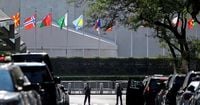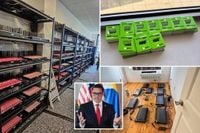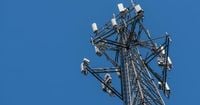In a dramatic turn of events just as world leaders gather in New York for the United Nations General Assembly, the U.S. Secret Service has announced the dismantling of a sprawling illegal network of electronic devices that officials say could have crippled the city’s telecommunications infrastructure and threatened the safety of senior U.S. government officials. The discovery, which unfolded over the past several months, has sent ripples through national security circles and raised urgent questions about foreign interference, cyberattacks, and the vulnerabilities of modern urban life.
The announcement came on September 23, 2025, with Secret Service Director Sean Curran emphasizing the gravity of the threat. “The potential for disruption to our country’s telecommunications posed by this network of devices cannot be overstated,” Curran declared in a statement, as reported by ABC News and several other outlets. The operation, which involved federal, state, and local agencies, uncovered more than 300 co-located SIM servers and over 100,000 SIM cards scattered across multiple sites within a 35-mile radius of Manhattan—right as more than 150 world leaders, including President Donald Trump, arrived in the city for the UN Assembly.
According to The New York Post, the trove of equipment was capable of sending up to 30 million anonymous text messages per minute—a volume sufficient to overwhelm and potentially shut down the region’s interconnected phone systems. Such an attack could have jammed 911 calls, disabled cell towers, and left millions of New Yorkers without the ability to communicate, drawing chilling comparisons to the cellular blackouts that followed the September 11 attacks.
Matt McCool, the special agent in charge of the Secret Service’s New York field office, explained the urgency: “It can take down cell towers, so then no longer can people communicate, right? … You can’t text message, you can’t use your cell phone. And if you coupled that with some sort of other event associated with UNGA, you know, use your imagination there, it could be catastrophic to the city.”
The operation began in the spring of 2025, when agents were first tipped off during their routine protective work for the president and other top officials. According to a law enforcement source cited by ABC News, the initial investigation focused on threats to three individuals, including one with direct access to President Trump. As the probe unfolded, agents stumbled upon a sophisticated web of servers and SIM cards, many already activated and others ready for deployment. The sheer scale of the cache—rows of servers and shelves stacked with SIM cards—stunned even seasoned investigators.
Officials believe the plot is connected to the Chinese government, though the investigation remains ongoing and no arrests have been made. The Secret Service has been tight-lipped about certain details, citing both the sensitivity of the ongoing probe and the international implications of their findings. As reported by NBC New York, early forensic analysis points to cellular communications between a well-funded group and individuals already known to federal law enforcement, but the full extent and intent of the operation are still being unraveled.
While investigators have not uncovered a direct plot to disrupt the United Nations General Assembly, the proximity and timing of the discovery—just as the world’s leaders convened in Manhattan—prompted an immediate and robust response. “Given the timing, location and proximity and potential for significant disruptions to the New York telecoms system, we moved quickly to disrupt this network,” McCool said, as quoted by AMNY.
The dismantled network enabled not only the potential for mass disruption but also allowed for anonymous, encrypted communications between threat actors and criminal enterprises. This capability, officials warn, could have facilitated the operations of organized crime groups, cartels, and even terrorist organizations, all while evading detection. “These devices allowed anonymous, encrypted communications between potential threat actors and criminal enterprises, enabling criminal organizations to operate undetected,” McCool told AMNY.
Forensic teams are now undertaking the painstaking task of analyzing the equivalent of 100,000 cell phone data sets. “We need to do forensics on 100,000 cell phones, essentially all the phone calls, all the text messages, anything to do with communications, see where those numbers end up,” McCool explained, underscoring the vast scope of the investigation. Early indications suggest the network’s operators may have been using the system to send encrypted messages to a range of illicit actors, but officials are not yet ready to pin down specific suspects or motives.
The Secret Service’s efforts have drawn on support from Homeland Security Investigations, the Department of Justice, the Office of the Director of National Intelligence, the NYPD, and other state and local agencies. The operation highlights the increasing complexity of threats facing major urban centers, especially during high-profile international events. As the United Nations General Assembly continues through September 29, security remains tight, with officials taking no chances amid a climate of global unrest and domestic political tensions.
Despite the seriousness of the threat, officials have been careful to reassure the public that there is no ongoing danger to New York City. “He emphasized that the recovered devices no longer pose a threat to New York or the surrounding region,” AMNY reported, quoting McCool. Nonetheless, the investigation remains active and open, with agents determined to “run down all leads until we fully understand the intent of the operation and identify those responsible.”
The Secret Service has not yet identified any suspects or made arrests, and officials caution that much remains unknown. The agency has declined to specify how the plot was first uncovered or to provide further details about the parties involved, citing both the need for operational security and the delicate nature of international relations. As The Associated Press noted, “The agency did not say whether anyone has been arrested or identified as a suspect. The Secret Service said the investigation is ongoing.”
Director Curran summed up the agency’s approach: “The U.S. Secret Service’s protective mission is all about prevention, and this investigation makes it clear to potential bad actors that imminent threats to our protectees will be immediately investigated, tracked down and dismantled.” His words echo a broader concern about the vulnerabilities of the nation’s critical infrastructure—a concern that has only grown as technology becomes more deeply woven into the fabric of daily life.
As forensic analysis continues and the world’s attention remains focused on New York, the Secret Service’s swift action stands as a stark reminder of the ever-present risks facing modern cities—and the tireless efforts required to keep them safe, especially when the eyes of the world are watching.


